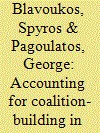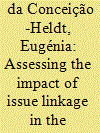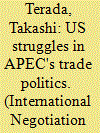|
|
|
Sort Order |
|
|
|
Items / Page
|
|
|
|
|
|
|
| Srl | Item |
| 1 |
ID:
103994


|
|
|
|
|
| Publication |
2011.
|
| Summary/Abstract |
Which parameters affect coalition building in budgetary negotiations? In this article, three distinct levels of analysis are identified to account for coalition building patterns, associated with domestic politics, domestic socioeconomic structures and EU politics. At the level of domestic politics, ideology points to cross-governmental affinity of a partisan nature; at the level of socioeconomic structures, similarity of policy interests, generated by cross-national socioeconomic convergence with EU policy standards, informs coalition formation patterns; at the EU politics level, the intergovernmental power balance influences the political aspirations of each Member State in the integration process and coalition-building decisions. Two sets of parameters affect the evolution of EU coalition patterns, corresponding to the integration impact on the EU (new cleavages) and on the Member States (the impact of Europeanisation). This analytical framework is used to examine the southern coalition (Spain, Greece, Portugal) in the four multi-annual financial frameworks (1988, 1992, 1999 and 2005).
|
|
|
|
|
|
|
|
|
|
|
|
|
|
|
|
| 2 |
ID:
084428


|
|
|
|
|
| Publication |
2008.
|
| Summary/Abstract |
Although issue linkage is often an important variable in negotiations, it remains an underdeveloped research area in European integration studies. This article attempts to assess the impact of issue linkage on EU bargaining outcomes by applying the Tollison and Willett spatial model of issue linkage to a key bargaining situation in the common fisheries policy: the negotiations on the introduction of the common market organization and structural policy. This article attempts to demonstrate how deals can be completed through issue linkage packages and to identify the conditions that make issue linkage more likely.
|
|
|
|
|
|
|
|
|
|
|
|
|
|
|
|
| 3 |
ID:
120717


|
|
|
|
|
| Publication |
2013.
|
| Summary/Abstract |
Abstract From a perspective of change in the institution's function, the history of the Asia-Pacific Economic Cooperation (APEC) can be divided into four periods: 1989-1995, 1996-2001, 2001-2006, and 2007-present. APEC's activities in each of these periods have been organized around major themes: respectively, the establishment of guidelines for liberalization; the implementation of liberalization measures; security issues such as counter-terrorism; and the establishment of a free trade area. American political will can be seen as a major driving force behind these changes in APEC's agenda-setting. However, norm setting during the first and second periods encountered objections from China and Japan, respectively. During the third period, the Bush administration's interest in combating terrorism through APEC was not supported by Asian members, who emphasized APEC's primary role as a framework for economic cooperation, instead placed higher priorities on East Asian regionalism that excluded the US. In light of this shift, in the fourth period, the US once again urged that APEC should be used as a framework for liberalization and pushed for the Trans-Pacific Partnership (TPP). This period saw the discriminatory, legally-binding and reciprocity-based norms for trade liberalization take root in APEC, resulting largely from the American coalition-building approach through the promotion of the TPP as an existing integration framework. This has helped to create a critical mass while competition with China over regional trade policies becomes more intense, demonstrating the case where the US successfully set its own preferred agenda and norm together for the first time.
|
|
|
|
|
|
|
|
|
|
|
|
|
|
|
|
|
|
|
|
|